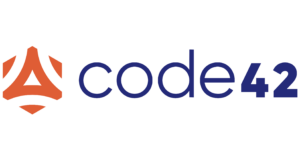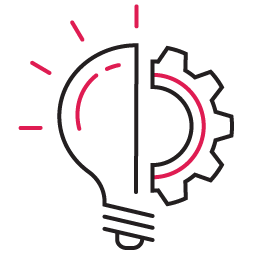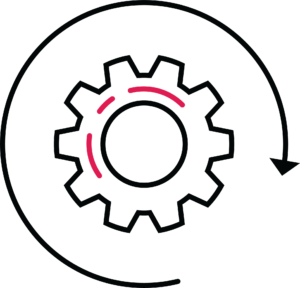Enterprise Architecture Management (EAM) FAQs addressed in this article:
-
What is the role of Enterprise Architecture Management in IT investment? – Enterprise Architecture Management (EAM) aligns technology investments with business goals, ensuring IT initiatives support and drive business objectives, optimizing IT portfolios for growth and innovation.
-
How does Enterprise Architecture Management enhance business outcomes? – By aligning IT initiatives with business goals, EAM enables organizations to navigate digital transformation effectively, making IT a catalyst for growth and ensuring technology investments deliver strategic value.
-
Why is robust portfolio management important in Enterprise Architecture Management? – Robust portfolio management within EAM prioritizes IT projects based on their potential value, ensuring resources are allocated efficiently and IT investments are closely aligned with business priorities.
-
What challenges does Enterprise Architecture Management address in measuring IT value? – EAM addresses the challenge of quantifying the direct and indirect impacts of IT investments on business performance, offering a framework to assess IT value beyond traditional financial metrics.
-
How do integrations enhance decision-making in Enterprise Architecture Management? – Integrations between EAM tools and platforms like LeanIX, ServiceNow, and CMDB provide a holistic view of the IT ecosystem, enabling smarter, strategic decisions by identifying synergies and streamlining operations.
-
Why is collaboration important in Enterprise Architecture Management? – Collaboration ensures that architectural decisions and IT investments are transparent and understood across the organization, fostering a culture where IT strategies are developed with input from diverse teams and aligned with overall business objectives.
-
How does Enterprise Architecture Management support future business planning? – EAM tools and methodologies enable organizations to visualize current IT landscapes and model future scenarios, helping to assess the impact of strategic decisions and plan for various contingencies.
-
What are the benefits of integrating Enterprise Architecture Management into business strategy? – Integrating EAM into business strategy ensures technology investments are not just cost-effective but strategically positioned to support long-term business objectives, unlocking IT’s full potential as a driver of business success.
For modern organizations, establishing agile ways of working across the entire enterprise is mission-critical to remain competitive. The strategic importance of Enterprise Architecture Management (EAM) cannot be overstated.
EAM stands at the crossroads of IT and business strategy, providing a crucial framework for aligning technology investments with business goals. This alignment is essential for organizations looking to navigate the complexities of digital transformation, optimize their IT portfolios, and ensure that technology serves as a catalyst for growth rather than a barrier.
However, integrating EAM into IT, finance, and agile planning processes presents its own set of challenges, from measuring the value and return on investment (ROI) of IT initiatives to ensuring that technology decisions are in lockstep with business priorities. This blog post delves into the strategic integration of EAM and portfolio management, the hurdles organizations face in quantifying IT value, and the transformative potential of leveraging integrations for smarter, more cost-effective decisions. Through exploring these themes, we aim to shed light on how organizations can enhance their IT investment decisions and achieve superior business outcomes through effective EAM integration.
This post is largely based on our recent webinar, Improving IT Investment Decisions and Business Outcomes with Integrated Enterprise Architecture Management. Click here to watch the full webinar at your convenience.
Challenges With the Strategic Integration of Enterprise Architecture Management and Portfolio Management
The integration of Enterprise Architecture Management within IT, finance, and agile planning processes is crucial for organizations aiming to navigate the digital landscape effectively, ensuring that every IT initiative not only supports but actively drives business objectives forward. At the core of this strategic integration lies the importance of robust portfolio management—a discipline that enables organizations to manage their IT investments as a cohesive portfolio, prioritizing projects based on their potential to deliver value and drive innovation.

However, achieving this level of strategic integration requires a deep understanding of both the current IT landscape and the future direction of the business. Organizations must be able to assess the impact of emerging technologies, understand the complexities of their existing IT infrastructure, and make informed decisions about where to allocate resources. These requirements can present challenges, especially for organizations moving ahead without professional guidance.
This is where the principles of EAM become invaluable. By providing a framework for understanding and managing the relationships between an organization’s IT assets and its business processes, EAM enables organizations to make strategic decisions that optimize the value of their IT investments.
Moreover, effective portfolio management under the umbrella of EAM ensures that IT initiatives are not only aligned with business goals but also managed in a way that maximizes efficiency and minimizes risk. It allows organizations to take a holistic view of their IT investments, identifying opportunities for consolidation, rationalization, and innovation. This holistic approach is essential for managing the complexities of modern IT environments, where the rapid pace of technological change and the increasing demand for digital services can quickly lead to fragmented and inefficient IT landscapes.
Overcoming measurement challenges and enhancing IT value
One of the most significant hurdles organizations face in the realm of EAM is the challenge of accurately measuring IT value and ROI. This difficulty stems from the complex nature of IT investments, which often have indirect impacts on business performance and can be hard to quantify using traditional financial metrics.
The value of IT initiatives also frequently extends beyond immediate financial returns, encompassing improvements in operational efficiency, customer satisfaction, and competitive advantage. These broader impacts, while crucial to long-term success, can be elusive and difficult to measure.
To navigate these challenges, organizations must adopt a more nuanced approach to evaluating IT value.
The strategic importance of IT initiatives
This involves moving beyond simple cost-benefit analyses to consider the strategic importance of IT initiatives and their alignment with business goals. It requires a framework that can capture both the direct and indirect benefits of IT investments, including their contribution to business agility, innovation, and market responsiveness.
EAM provides such a framework, offering tools and methodologies for assessing the value of IT in terms of its support for business processes and its role in driving strategic outcomes.
Optimizing the allocation of IT resources

Furthermore, enhancing IT value through EAM involves not just measuring the outcomes of IT initiatives but also optimizing the allocation of IT resources. This includes making strategic decisions about which projects to pursue, how to allocate budget and personnel, and when to sunset legacy systems in favor of new technologies. By providing a comprehensive view of the IT landscape and its relationship to business objectives, EAM enables organizations to make these decisions with greater confidence and precision.
Identify inefficiencies and waste
In addition, EAM can help organizations identify opportunities to reduce costs and eliminate inefficiencies within their IT portfolios. By analyzing the current state of IT assets and their alignment with business needs, organizations can pinpoint areas where resources are being underutilized or where redundant systems can be consolidated. This not only reduces the total cost of ownership for IT but also frees up resources that can be invested in more strategic initiatives, further enhancing the value of IT to the business.
Leveraging Integrations for Smarter Decisions
The integration of EAM tools with other platforms such as Apptio Targetprocess, LeanIX, ServiceNow, or Jira Service Management coupled with a CMDB (Configuration Management Database) plays a pivotal role in connecting initiatives, business capabilities, and applications.
Supports strategic decision making
This interconnectedness is crucial for making informed, strategic decisions that not only reduce costs but also eliminate inefficiencies across the IT landscape. By leveraging these integrations, organizations can gain a holistic view of their IT ecosystem, enabling them to identify synergies, streamline operations, and drive more value from their IT investments.
Provides deeper understanding of the technology landscape
Integrating EAM tools offers a comprehensive understanding of the technology landscape, including the relationships between applications, technologies, and business processes. This visibility is essential for identifying areas of overlap, redundancy, or underutilization within the IT portfolio.
For instance, by understanding how different applications support various business capabilities, organizations can pinpoint redundant applications that serve similar purposes and consolidate them, thereby reducing complexity and cost.
Enhances your ITSM practice and compliance efforts
Similarly, the integration of EAM with an ITSM tool and CMDB enhances IT service management by providing a detailed inventory of IT assets and their configurations. This integration facilitates better change management, incident management, and problem resolution processes by ensuring that decision-makers have access to accurate, up-to-date information about the IT environment. It also supports compliance and risk management efforts by enabling organizations to track the lifecycle of each IT asset and ensure that all systems are up to date and secure.
Powers smarter IT investment decisions
Moreover, these integrations empower organizations to make smarter investment decisions by providing a data-driven foundation for evaluating new initiatives. By analyzing the current state of the IT landscape and its alignment with business objectives, decision-makers can identify strategic opportunities for investment that will deliver the greatest impact.
This could include investing in new technologies that fill gaps in the IT portfolio, enhancing existing systems to support new business capabilities, or divesting from legacy technologies that no longer add value.
Fostering Transparency, Collaboration, and Future Planning
The successful integration of EAM within an organization’s strategic framework necessitates a culture of transparency and collaboration across teams and departments. This collaborative environment is essential for effective decision-making and for the use of Enterprise Architecture Management to visualize and model current and future states.
By fostering a culture where information flows freely and stakeholders from various functions are engaged in the planning process, organizations can ensure that their IT strategies are fully aligned with their business objectives and are adaptable to future changes.
Transparency in EAM
Transparency in the context of EAM means making architectural decisions, IT investments, and strategic roadmaps visible and understandable to all relevant stakeholders. This openness helps to demystify IT operations for non-technical team members and ensures that everyone has a clear understanding of how IT initiatives support the organization’s goals. It also encourages feedback and input from a wider range of perspectives, leading to more well-rounded and effective IT strategies.
Collaboration in EAM
Collaboration, on the other hand, involves bringing together diverse teams—including IT, finance, operations, and business units—to jointly plan and execute IT initiatives. This collaborative approach ensures that IT investments are not made in silos but are instead closely aligned with the needs and priorities of the entire organization. It also enables more agile decision-making, as teams can quickly come together to address emerging challenges or capitalize on new opportunities.
Future planning via EAM
Furthermore, EAM facilitates future planning by providing tools and methodologies for visualizing the current state of the IT landscape and modeling potential future scenarios. This capability allows organizations to assess the impact of different strategic decisions and plan for various contingencies.
By understanding how changes to the IT architecture will affect business processes and capabilities, organizations can make more informed decisions about where to invest in new technologies, when to retire legacy systems, and how to adapt their IT strategies to support long-term business objectives.
Are You Ready to Integrated Enterprise Architecture Management Into Your Portfolio Management Processes?
The journey towards integrating Enterprise Architecture Management into the strategic fabric of an organization’s IT, finance, and agile planning processes is transformative. It’s a journey that not only refines IT investment decisions but also propels businesses towards achieving unparalleled outcomes. By ensuring that technology investments are in harmony with business goals, organizations can adeptly navigate the intricacies of digital transformation, positioning IT as a pivotal catalyst for growth and innovation.
For those eager to delve deeper into the intricacies of Enterprise Architecture Management and its influence on IT investment strategies, the full webinar this article was based on offers a wealth of insights and actionable strategies, as well as practical demos showing how Apptio Targetprocess can power an integrated EAM practice. Watching it on demand can illuminate the path forward, providing the knowledge and tools necessary to navigate the complexities of EAM.
Furthermore, engaging with specialized consulting services in EAM and ITFM can present bespoke solutions tailored to the unique challenges and opportunities your organization faces.
We encourage you to learn more and contact us with any questions, or to move forward with your EAM integration.
























 To be successful in today’s business landscape, you need to be agile and efficient. One way to achieve this is by adopting modern, cloud-based tools like Atlassian Cloud. However, simply adopting the tool isn’t enough. You must fine-tune your processes and workflows to fully incorporate Atlassian Cloud capabilities.
To be successful in today’s business landscape, you need to be agile and efficient. One way to achieve this is by adopting modern, cloud-based tools like Atlassian Cloud. However, simply adopting the tool isn’t enough. You must fine-tune your processes and workflows to fully incorporate Atlassian Cloud capabilities. Performing repetitive tasks manually is laborious and cumbersome. Besides being wildly inefficient, it’s not beneficial to employee morale. Assigning someone to perform these duties under-uses and undervalues their expertise. If your pre-migration processes relied on performing tasks manually, you’ll want to adjust those processes once you’ve moved to Atlassian Cloud.
Performing repetitive tasks manually is laborious and cumbersome. Besides being wildly inefficient, it’s not beneficial to employee morale. Assigning someone to perform these duties under-uses and undervalues their expertise. If your pre-migration processes relied on performing tasks manually, you’ll want to adjust those processes once you’ve moved to Atlassian Cloud. Another reason to update your organization’s processes is to improve inter-team communication and reduce siloing. If silos bind your pre-migration workflows, you’ll actively need to fight siloing leading up to and following your Atlassian Cloud migration.
Another reason to update your organization’s processes is to improve inter-team communication and reduce siloing. If silos bind your pre-migration workflows, you’ll actively need to fight siloing leading up to and following your Atlassian Cloud migration. Solution Partners can also provide ongoing support and training to ensure your organization uses Atlassian Cloud tools to their full potential.
Solution Partners can also provide ongoing support and training to ensure your organization uses Atlassian Cloud tools to their full potential.